Home | Front Page | Index | Blog | New | Contact | Site Map
Cartagena
Mompos
Giron
Bucaramanga
San Gil
Barichara
Socorro
Villa De Leyva
Tunja
Bogota
Foto Show
Central America
Belize
Guatemala
Honduras
Nicaragua
Costa Rica
Panama

Mompox Shield |
Once upon a time, before silting up, the Magdalena was an important freight artery and Mompos an important town. Perhaps it could be compared to Savannah, Georgia, although we don't know enough about Savannah except to say that it and Mompos both have elegant waterfront homes and declined from their once-prominent positions.
We'd agreed on Mompos in spite of Lonely Planet's warning there could be some danger from rebellious groups, because it was esentially Mompos or nothing: just take a plane or a 20-hour bus ride to Bogota. But that doesn't mean we made a leap in the dark. We had taken the precaution of getting expert opinion: a restaurant owner, the clerk at our hotel, and a know-nothing person in the tourist office. All were sure it was safe. All except Jan, that is.
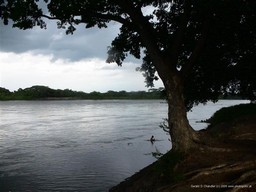
The Magdelena River |
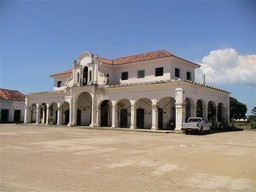
The Great Riverfront House |
The trip to Mompos was an unexpected combination of comfort, boredom, and — to repeat a word — the unexpected. Our all-comfort, air-con, TV-equipped bus left the terminal right on time and headed south east. We passed more of Cartagena, the un-interesting newer, poorer parts, that rush-in-rush-out tourists never see. Soon we were in countryside, but not too interesting country side, since it was low-land with no distinguishing features and little in the way of interesting flora or fauna. Around noon we came to our third or forth tiny town and at this one we stopped. Upon inquiry we were told we'd be there an hour; something that seemed strange. We sat at a table and read and drank some of our 2.5 liter soda, and waited.
In only a half-hour we found the explanation: we'd been waiting for the ferry. The buck may stop in the president's office but the road stops in tiny Yati. Our bus was one of the last vehicles to get on. After we'd left the bank another bus came along, the ferry returned, the bus was put on, it didn't fit, it was taken off, a smaller bus was taken off, the new, larger bus put on it is place, and the smaller bus crowded on. Then we were truly off. After an hour the ferry ride came to an end, and we drove 45 minutes through more flat, delta land.
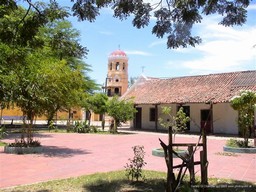
Santa Barbara Church Tower |
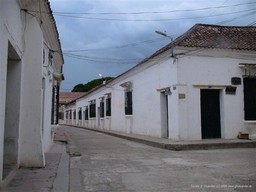
A Street of White Washed Houses |
Mompox won our hearts without even trying. While Jan watched the bags Gerry set off to find a hotel. As he walked down the quiet main drag, Calle Real de Medio, he couldn't help smiling to himself: this is fine! Mompox is very small, only a few blocks square but almost every square inch is authentic Spanish colonial (17th to 18th century). That means single-storey, courtyard houses with red-tile roofs, white-washed walls, wrought-iron grilles on windows, and high ceilings interspersed with colonial churches, each one a gem.
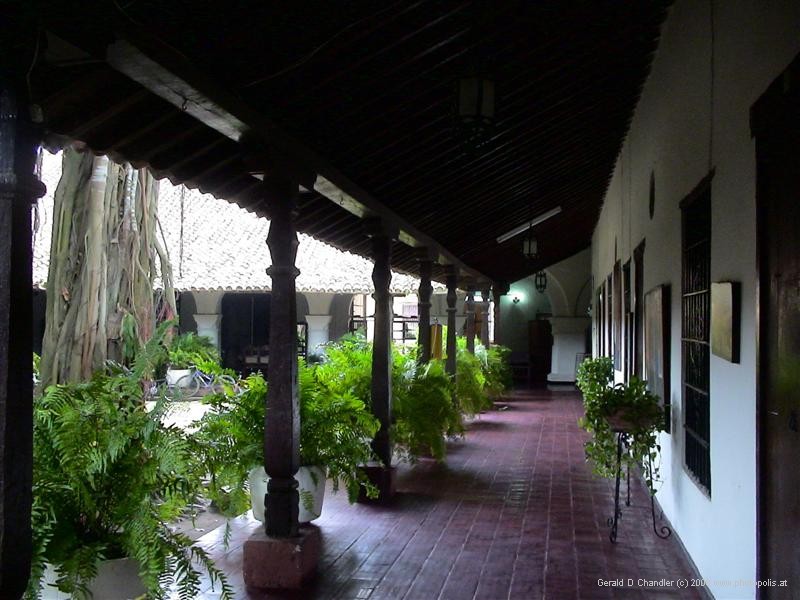
Courtyard Arcade in Hostal Doña Manuela |
Gerry found us an acceptable hotel for our first night, but the next day in a walk we found a better one. To make the move worth our while, we decided to extend our stay from two days to three. The new place, Hostal de Doña Manuela, was once a monastery and drew us in with its three courtyards — and, big surprise, a modern addition, a very modern swimming pool that disappointed only because its cool-looking waters were actually hot. Our room was very simple, but came with private bath and air-conditioning and plenty of room for all our bags.
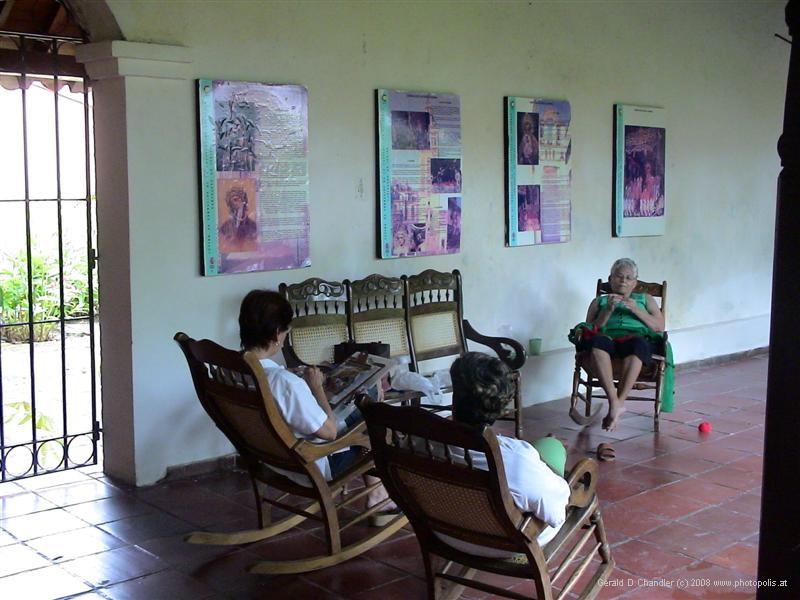
Women in Casa de la Cultura |

Errand Boy at Door |
We filled our days mostly just wandering the narrow streets gawping at the buildings and marvelling at the fact that we were the only tourists in town. Eventually we did manage a visit to the Casa de la Cultura, where a very enterprising young man tried to sell us a guided tour to some nearby nature reserve.
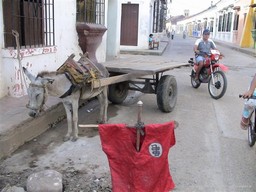
Street Life: Rebuilding a house |
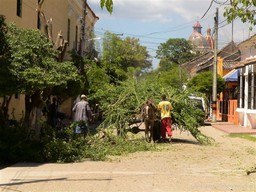
Street Life: Trimming Trees |
We walked the town from one end to the other and from one side to the other. We found that there were at least two internet cafes in town, but were shocked to learn that one of them would not allow USB connections. There were also at least two ATM machines, but only one would accept our foreign cash card.
Perhaps the only complaint we could level at Mompos was the time at which we had to leave it. There is no bus to carry passengers further south, so we had to make do with a so-called collectivo. It turned out to be a long wheel-base jeep that bounced and shook for two hours to get to the nearest bus station in El Banco.
